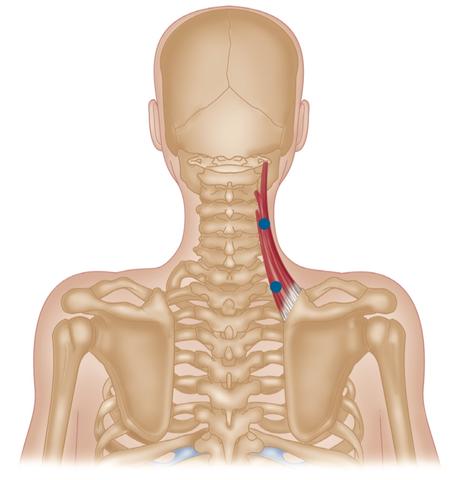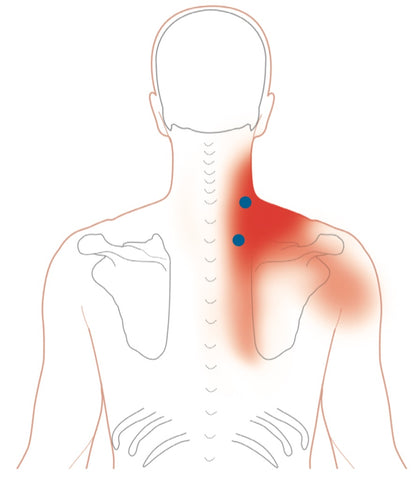Levator Scapulae - Snapping Scapula Syndrome

Snapping scapula syndrome is defined as an audible or palpable clicking of the scapula during movements of the scapulothoracic joint
The Levator Scapulae muscle is an important muscle in the neck. It has a key role in lateral flexion and rotation of the neck. If the Levator Scapulae is injured or overactive, it can cause pain and tightness in the shoulder blade. To help relieve pain caused by the Levator Scapulae, you can perform stretches and physical therapy exercises to relieve tension and improve function.
The Levator Scapulae is located in the lateral cervical region and is located close to the sternocleidomastoid muscle at its origin. At its lower portion, it is covered by the trapezius muscle. In the upper part, it lies under the splenius capitis.
When the Levator Scapulae muscle becomes overactive, it can lead to a condition known as snapping scapula syndrome. This is a common condition that can be a result of overuse, injury, or muscle imbalance. Symptoms include deep aching, pain, or tightness in the scapulae. Besides affecting the shoulder, these symptoms can also affect the neck and a person's ability to turn the head to the side. Fortunately, there are ways to prevent a snapping scapulae from developing. Among these ways are proper sitting and sleeping positions, avoiding repetitive arm motions, and performing stretching and massage procedures.
The Levator Scapulae muscles insert into the superior part of the medial border of the scapula. These muscles originate from the posterior tubercles of the transverse processes of the first four cerebral vertebrae. Lowermost fibers insert laterally, while the superior fibers insert medially. There are many attachments to the scapula, and the number and location of these attachments can vary between individuals.
A strain of the levator scapulae can be painful and may affect the glenohumeral joint. Although a mild sprain can allow you to continue your activities, severe strains can lead to tenderness, swelling, and bruising, as well as limited range of motion. Chronic levator scapulae strains can develop into tendonitis and degeneration of the muscle. Performing various stretching and massage techniques can improve the scapulae's function and reduce its sensitivity to stress.
During the abduction stage of shoulder movement, the Lev Scapulae actively contracts to support the shoulder blade. However, during the postural phase of the shoulder movement, the muscle works eccentrically to prevent the scapula from extending upward. During this time, it is unable to lift the scapula, but it can tilt the glenoid cavity inferiorly. During this time, the Lev Scap can also assist the upper serratus anterior in cervical extension.
Symptoms of a strained levator scapulae usually involve pain and tightness in the shoulder blade, especially in the scapulae. Tightness can also be accompanied by neck pain, shoulder blade discomfort, and headaches. Since the Levator Scapulae controls the neck, a stiff scapulae can hinder its normal function. For these reasons, it is vital to stretch the muscles after a shoulder rotation. Doing so will also prevent a scapula from developing a shortened arc.
Stretching and massage can help to treat a strained levator scapulae. Depending on the extent of the muscle's irritation, you can use a variety of modalities, including massage, physical therapy, and trigger point therapies. Combined with other treatments, manual therapies may typically improve a person's scapulae's function.
The levator scapulae acts eccentrically to decelerate the downward forces created by the lower fibers of the trapezius and serratus anterior. The levator scapulae decelerates contralateral side flexion in the cervical spine.
Almost all neck pain will have myofascial trigger point contributions, and this muscle is commonly involved.
Pain will be experienced at the angle of the neck from the superior angle, making its way down to the medial aspect of the inferior angle, with spillover all the way along the medial border of the scapula.
Clients will often present with a stiff neck and reduced range of motion.

Levator Scapulae - Common Trigger Point Sites
Origin
Posterior tubercles of transverse processes of first three or four cervical vertebrae (C1–4).
Insertion
Medial (vertebral) border of scapula, between superior angle and spine of scapula.
Connections
Action
Elevates scapula. Helps retract scapula. Helps bend neck laterally.
Nerve
Dorsal scapular nerve C4, 5, and cervical nerves C3, 4.
Basic Functional Movement
Example: carrying a heavy bag.
Sports that heavily utilize this muscle
Examples: shot put, weightlifting.

Levator Scapulae - Typical Referred Pain Patterns
Trigger Point Referred Pain Patterns
Triangular pattern from top of scapula to nape of neck. Slight overspill to medial border of scapula and posterior glenohumeral joint.
Indications
Stiff and painful neck with limited rotation of cervical spine, long-term use of walking stick, neck pain and stiffness, problems turning neck (e.g. driving).
Causes
RTA, holding telephone ear to shoulder, side sleeping with wrong pillows, backpacks, poor posture, sustained habits or occupation, TV/monitor position, stress and tension, cold/flu or cold sores, sports (swimming front crawl).
Differential Diagnosis
Scapulothoracic joint dysfunction; winging of scapula. Apophysitis and capsular-ligamentous apparatus. Shoulder impingement syndromes.
Trigger Point Treatment Techniques
| Spray and Stretch | YES |
| Deep Stroking Massage | YES |
| Compression | YES |
| Muscle Energy Techniques | YES |
| Positional Release | YES |
| Dry Needling | YES |
| Wet Needling | YES |
Self help
Self-massage techniques can be very helpful; especially balls and pressure tools.
General advice to patients
Hold telephone shoulder to ear. Stress. Occupation. Air conditioning. Passive stretching. Heat and warmth. Scarf in cold weather. Change walking stick position.
About Niel Asher Education
Niel Asher Education (NAT Global Campus) is a globally recognised provider of high-quality professional learning for hands-on health and movement practitioners. Through an extensive catalogue of expert-led online courses, NAT delivers continuing education for massage therapists, supporting both newly qualified and highly experienced professionals with practical, clinically relevant training designed for real-world practice.
Beyond massage therapy, Niel Asher Education offers comprehensive continuing education for physical therapists, continuing education for athletic trainers, continuing education for chiropractors, and continuing education for rehabilitation professionals working across a wide range of clinical, sports, and wellness environments. Courses span manual therapy, movement, rehabilitation, pain management, integrative therapies, and practitioner self-care, with content presented by respected educators and clinicians from around the world.
Known for its high production values and practitioner-focused approach, Niel Asher Education emphasises clarity, practical application, and professional integrity. Its online learning model allows practitioners to study at their own pace while earning recognised certificates and maintaining ongoing professional development requirements, making continuing education accessible regardless of location or schedule.
Through partnerships with leading educational platforms and organisations worldwide, Niel Asher Education continues to expand access to trusted, high-quality continuing education for massage therapists, continuing education for physical therapists, continuing education for athletic trainers, continuing education for chiropractors, and continuing education for rehabilitation professionals, supporting lifelong learning and professional excellence across the global therapy community.

Continuing Professional Education
Looking for Massage Therapy CEUs, PT and ATC continuing education, chiropractic CE, or advanced manual therapy training? Explore our evidence-based online courses designed for hands-on professionals.


















